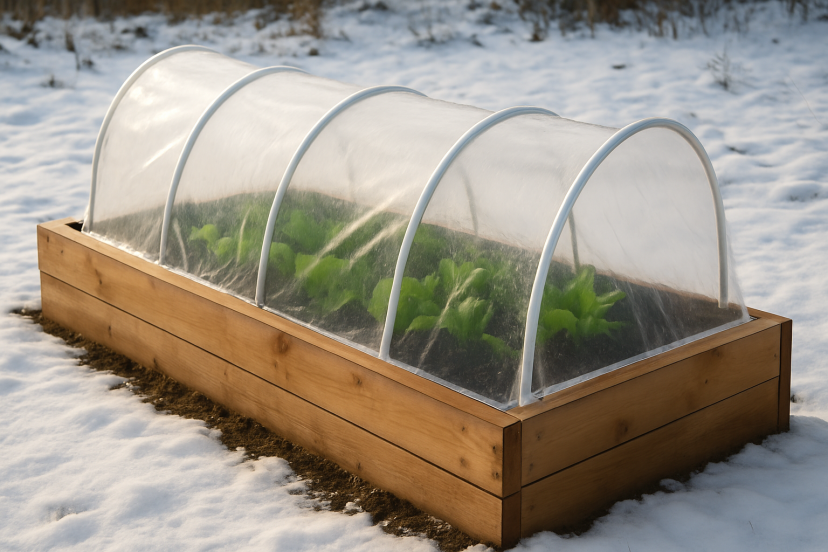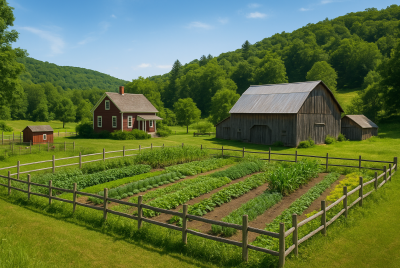5 DIY Raised Beds for Comfort & Ergonomics in Cold Weather
We may earn a commission for purchases made using our links. Please see our disclosure to learn more.
If you’re planning to use DIY raised beds for cold-weather gardening, you’re choosing one of the most efficient ways to keep plants healthy when temperatures drop. Raised beds warm up earlier in spring, drain better after rain or snow, and make it easier to work without bending or kneeling.
Whether you’re growing winter greens, hardy herbs, or root crops, raised beds give you more control over soil quality and temperature. With the right design and materials, you can protect your plants from frost, reduce strain on your body, and keep your garden productive through the colder months.
The Benefits of Ergonomic Raised Beds
Comfort plays a huge role in whether winter gardening feels enjoyable or like a chore you dread. That’s where ergonomically designed diy raised beds stand out. Not only do they improve plant health, but they also protect your body from unnecessary strain.
Better Posture & Less Physical Stress
A raised bed at hip or waist height eliminates constant bending and kneeling. For gardeners with stiff joints, sore backs, or limited mobility, this small change makes a world of difference.
Extended Growing Season
Since raised beds are elevated above the ground, their soil warms sooner in the spring and holds warmth later into the fall. Add a simple hoop tunnel or insulating cover, and you can successfully grow well into the colder months.

Improved Soil Structure
You control exactly what goes into the bed—compost, drainage layers, and nutrient-rich soil—without worrying about compacted, frozen, or soggy ground.
Easier Cold-Weather Access
Snow melts faster on raised surfaces, which means you don’t need to shovel your way into the garden every time you want to check your plants.
When you combine ergonomic comfort with better soil performance, raised beds quickly become one of the smartest upgrades for winter gardening.
Why Warmer Soil Matters in Cold-Weather Gardening
Cold-weather gardening isn’t just about shielding plants from frost—it’s about giving the soil enough warmth to keep roots alive and active. A technical review by Yara International explains that soil temperature plays a critical role in nutrient uptake, germination, and plant vigor, emphasizing that raised beds warm faster because they sit above ground and drain more efficiently. Many homesteaders notice this firsthand: even after a chilly night, the soil in a raised bed often feels noticeably warmer than the surrounding ground, allowing earlier planting and healthier root development.
Another valuable insight comes from multi-year mulch studies, such as a 2023 muskmelon trial that found mulched soil maintained higher temperatures and produced stronger yields than bare soil. While the research focused on mulch rather than raised beds directly, the takeaway applies perfectly: when you help soil retain warmth—whether through insulation, straw bales, or protective coverings—you give plants a more stable and productive environment. This supports the effectiveness of straw-bale hybrids, insulated cedar beds, and tunnel-style designs that hold heat around the root zone during cold spells.

5 DIY Raised Bed Designs Perfect for Cold Weather
Below are five diy raised beds styles that blend comfort, accessibility, and strong cold-weather performance. Each option can be personalized, making them suitable for both beginner and experienced homesteaders.
1. Waist-High Cedar Raised Bed with Insulation
This design is a winter favorite because of its elevated height and natural durability. Cedar naturally resists moisture, decay, and pests, making it ideal for long-term outdoor use. By building it to waist height, you keep every plant comfortably within reach.
Why it works in winter:
- Lining the interior with rigid foam insulation helps retain heat.
- Elevated soil warms faster and stays warmer longer.
- Reduced snow accumulation makes maintenance easier.
Ergonomic Benefits:
No bending, minimal reaching, and reduced knee stress—an excellent option for anyone wanting a more comfortable garden setup year-round.
2. Straw Bale Cold-Frame Hybrid Bed
If you’re looking for a budget-friendly but extremely effective cold-weather design, this hybrid style is a winner. You stack straw bales to form the outside walls and place a transparent lid—polycarbonate, acrylic, or even repurposed windows—on top.
Why it works in winter:
- Straw naturally insulates the soil.
- The cold-frame lid traps warmth like a mini greenhouse.
- Perfect for winter greens, cold-tolerant herbs, spinach, kale, and microgreens.
Ergonomic Benefits:
Straw bales create a comfortable working height and can be arranged in any shape that suits your space.
3. Metal Corrugated Bed with an Inner Heat Sink
Metal raised beds have become extremely popular because they warm rapidly under sunlight. Pairing them with a heat sink—stones, bricks, or even a buried black water barrel—creates a powerful thermal-storage system.
Why it works in winter:
- Metal absorbs warmth quickly during the day.
- The heat sink radiates warmth into the soil overnight.
- A perfect setup for fluctuating temperatures typical in early spring and late fall.
Ergonomic Benefits:
Most metal beds are tall enough to reduce bending, and their smooth edges provide easy access during cold-weather maintenance.
4. U-Shaped Wooden Bed for Maximum Ergonomics
If convenience is your priority, a U-shaped raised bed is hard to beat. This design creates a walkway in the middle, allowing you to reach every plant without stepping on the soil.
Why it works in winter:
- The enclosed shape helps retain warmth in the center.
- Easy to cover with plastic tunnels or row covers.
- Reduces heat loss when working in cold weather since movement is minimized.
Ergonomic Benefits:
Everything stays within arm’s reach, making planting, weeding, and watering incredibly efficient.
5. Mini Greenhouse Tunnel Bed
This is the ideal choice for gardeners who enjoy growing all year long—or at least want to stretch the season as much as possible. The PVC frame creates sturdy hoops, while a clear polyethylene cover shields plants from frost and wind.
Why it works in winter:
- Creates a warm, moist microclimate.
- Protects plants from freezing rain, snow, and sudden cold snaps.
- Works especially well for carrots, kale, winter lettuce, chard, and hardy herbs.
Ergonomic Benefits:
The added height from the hoops makes it easier to access crops without crouching or straining.
Recommended Products
Pair any of these raised bed designs with the following tools and accessories for better winter performance:
- Cedar Raised Garden Bed Kit – Durable, long-lasting wood ideal for elevated designs.
- Cold Frame Greenhouse Lid – Adjustable ventilation for frost protection.
- Corrugated Metal Panel Bed Kit – Strong heat absorption and excellent durability.
- PVC Hoop House Kit – Perfect for constructing tunnels over raised beds.
- Thermal Mass Stones or Bricks – Helps stabilize nighttime temperatures.
These items aren’t required but will make your winter gardening setup far more efficient and comfortable.
Final Thoughts
DIY raised beds make winter gardening more efficient and manageable. With the right height, materials, and insulation, they create a stable environment where plants can continue growing in cold weather. Options like cedar beds, straw-bale frames, and tunnel designs each offer practical advantages for handling frost and temperature changes.
Whether you’re new to homesteading or expanding your garden, raised beds remain a reliable way to improve cold-season productivity. Choose a design that fits your space and growing goals, and you’ll be able to maintain a steady harvest even when the weather turns cold.
FAQs
1. How deep should a raised bed be for winter gardening?
For best results, aim for a soil depth of about 12–18 inches. Deeper soil retains heat better and protects roots from sudden temperature drops.
2. Which materials help raised beds stay warmest?
Metal absorbs heat well, while straw and wood provide excellent insulation. Combining materials can improve performance even more.
3. Can I grow food in raised beds during freezing temperatures?
Yes. Using cold frames, tunnels, or row covers allows you to grow kale, spinach, carrots, green onions, and other cold-hardy crops all winter long.
4. Should I insulate my diy raised beds for winter?
If you live in a harsh climate, adding insulation—like straw, bubble wrap, or foam—helps soil stay warmer and extends the growing season.
5. Are raised beds worth the effort for cold-weather gardening?
Absolutely. They warm faster, drain better, improve comfort, and give you more control over soil health—making them ideal for winter and early-spring gardening.




